|
JEAN-GEORGES MALCOR
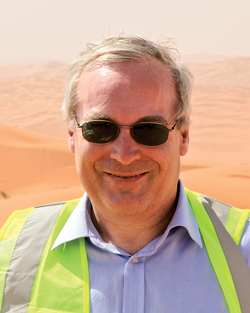
|
| A graduate of Ecole Centrale de Paris, Malcor also holds a master’s degree from Stanford University and a doctorate from Ecole des Mines. He began his career at the Thomson CSF group as an acoustic engineer in charge of hydrophone and geophone design and towed streamer programs. He then moved to Sydney, Australia-based Thomson Sintra Pacific, becoming managing director of the company in 1990. In 1996, he was appointed managing director of Thomson Marconi Sonar Australia, which was, in addition to its military activities, a leading developer of solid geophysical streamers. In 2002, he became senior vice president of Thales International. From 2004 to 2009, he was senior vice president in charge of the naval division, supervising all naval activities in Thales including ship design, building and maintenance. Malcor joined CGGVeritas in January 2010 as president and became CEO on June 30 of that year. |
|
CGGVeritas is celebrating its 80th anniversary this year. The international geophysical services provider was founded as Compagnie Générale de Géophysique (CGG) in 1931 and conducted its first survey in West Africa in 1932. CGG began conducting 3D seismic exploration in 1971 and acquired its first 4D survey in 1994. The company assumed its present name in 2007 by combining with Veritas. CGGVeritas includes legacy companies such as the US-based Digicon and Canadian software company Hampson-Russell. Sercel, the seismic equipment manufacturer, also operates within CGGVeritas’ corporate umbrella. CEO Jean-Georges Malcor provided his perspective to World Oil Editor Pramod Kulkarni on the outlook for the seismic industry and the current state of technology advancement in acquisition, data processing and interpretation.
World Oil: What is the outlook for the seismic industry in the near term and into the future?
Jean-Georges Malcor: Driven by increasingly challenging exploration, maturing reservoirs, declining production and continued growing energy demand worldwide, underlying oil and gas fundamentals are strong. With these dynamics and in the context of the uncertainties of the global economic environment, the outlook for the seismic industry is very favorable, especially for high-end seismic equipment, technologies and solutions.
As we continue to advance geophysical technology and techniques, I am confident that we will drive successful exploration to areas that today are not considered possible. For production, the need to extend the life of and maximize recovery from producing fields has never been greater, and reservoir seismic will continue to reduce the risks associated with production and ultimately the cost to produce. From life-of-field reservoir monitoring to integrated solutions for unconventional resources, reservoir seismic will play an increasingly critical role in the future.
Along with the value that seismic brought to exploration and its growing use for reservoir optimization, I also expect over time there will be a natural take-up of seismic to improve safety and reduce the environmental risks associated with finding and producing hydrocarbons. Each seismic advance brings a better understanding of the subsurface and, with it, the ability to drill fewer, more successful and safer wells.
World Oil: Will CGGVeritas be launching seismic newbuilds, setting up data centers, etc. over the next five to 10 years?
Malcor: In the marine sector, we are engaged in an ambitious program to renew and modernize our fleet. This is taking the form of decommissioning lower-end vessels, significantly upgrading others, and adding select newbuilds. By 2012, we will have decommissioned 14 vessels, upgraded five to high-end capability, and added three newbuilds, including two advanced X-BOW vessels and one fit-for-purpose 2D/3D vessel.
In data processing and imaging, with our current global footprint of 29 open and 12 dedicated centers, our business model is to maintain as close a proximity to our clients as possible. This approach, driven by our clients’ needs, encourages partnership and collaboration and enables CGGVeritas to bring innovations to the market that effectively address local challenges.
World Oil: Will you be investing in additional spec data projects?
Malcor: We don’t acquire seismic data on a speculative basis; instead, we build our library through multiclient investments. Typically, multiclient projects complete acquisition with a high level of prefunding from our sponsoring clients. Our multiclient library reflects a continuous investment in key basins. Our selection process is based on proven basin potential, favorable regulations for the multiclient business model and strong customer interest through active bidding and prefunding.
We’ve developed historical core positions and deep understandings in basins such as the Gulf of Mexico, Brazil and the North Sea and continuously leverage our advanced technology portfolio—including our state-of-the-art wide-azimuth acquisition capabilities, our BroadSeis broadband seismic solution, and our depth-imaging algorithms. We also continue to evaluate new opportunities, such as the recent development of a leading position in the Haynesville, Marcellus, Eagle Ford and Bakken shale basins.
We typically invest around $300 million a year in multiclient surveys, and expect this level of investment in 2011. In the Gulf of Mexico, post-Macondo, we continue to see high levels of prefunding, and have recently secured a new seismic permit and plan on initiating a further project before the end of the year.
Over the next five years, we will continue to develop our core areas as well as extend and diversify our portfolio, bringing the latest technology to bear and continuously providing our clients with a better understanding of the Earth’s potential.
World Oil: What are the current technology challenges in seismic data acquisition, processing and interpretation?
Malcor: Across the full breadth of seismic equipment, technology, services and solutions, there is a lot to cover. I will try to provide a brief overview.
First, we must continue with our traditional role of enabling our clients to increase their reserves through successful exploration in ever more challenging environments—as an example, in challenging operational areas where specialized equipment and experience in HSE are critical, such as the Arctic, transition zones, deep water and urban areas, as well as in complex geologic settings such as subsalt basins, sub-basalt prospects and unconventional reservoirs.
Second, we need to help our clients optimize recovery from existing fields. Advances in reservoir seismic will steadily develop and, already today, we have a full portfolio of reservoir monitoring capabilities from towed-streamer and Trilobit Ocean Bottom Nodes to our SeisMovie onshore real-time reservoir monitoring solution and our offshore Optowave fiber-optic permanent reservoir monitoring system. We also continue to advance our 4D processing and reservoir rock and fluid characterization capabilities through advanced seismic analysis provided by our Hampson-Russell Software & Services.
Third, we need to address the challenges that will enable the industry to tap into the potential of unconventional reservoirs. Advances in seismic technology will increase recovery rates in shale gas reservoirs and can help mitigate the risks of operating in these massive, heterogeneous and complex plays. To fully bring the benefit of seismic to bear on unconventional reservoirs will require the continued advance of integrated borehole services such as VSPs [vertical seismic profiles], microseismic and predictive reservoir property analysis. This effort requires going beyond standard reservoir characterization techniques that we developed to discriminate fluids and various rock properties to geomechanical reservoir characterization so that the stress and fracturing regime can be better understood.
Being able to address all of these challenges has certainly been a major development in seismic and will continue well into the future, but it is also just the tip of the iceberg. Advances in ultra-high-resolution, wide-azimuth and broadband techniques, such as our BroadSeis solution offshore and UltraSeis onshore, have brought a real step-change to the clarity and structural and stratigraphic detail available in seismic today.
Going further, in order to address the challenges of the future, it will be important to integrate the full spectrum of geophysical technologies.
Finally, though your question was about technology, I think it is important to address HSE and sustainable development, as continuous advances in these domains are as critical to the oil and gas industry’s success as technology. In these areas seismic, I believe, can play a significant role.
|
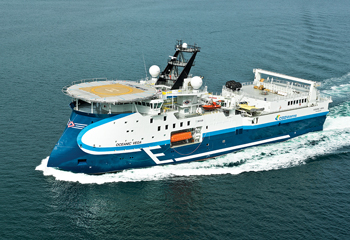
|
| By 2012, CGGVeritas plans to decommission 14 outdated vessels, upgrade five to high-end capability, and add three newbuilds, including two advanced X-BOW vessels and one fit-for-purpose 2D/3D vessel. |
|
World Oil: Does the seismic industry face regulatory challenges after the Macondo well blowout and the imposition of stricter environmental standards? What steps are the industry in general and CGGVeritas in particular taking to reduce the environmental footprint of onshore and offshore seismic operations?
Malcor: Recent catastrophic industrial incidents such as Macondo or Fukushima have raised legitimate public concerns around energy. As further regulations are deliberated globally, I believe it is important to consider how advanced seismic can reduce the environmental risks associated with drilling and production. As an example, advanced seismic can reduce the number of exploration and production wells required, detect potentially dangerous zones during drilling such as shallow gas or areas of overpressure, and provide real-time monitoring with solutions such as SeisMovie.
At CGGVeritas, we continue to advance our focus on ensuring that our operations take only data, and leave the communities where we live and work better than when we arrived. Since 2007, CGGVeritas has been a member of the United Nations Global Compact, and in 2010 we were selected for inclusion in the Ethibel Excellence Investment Register and for inclusion in the ASPI [Advanced Sustainable Performance Indices] Eurozone.
The oil and gas industry and the seismic industry, in particular, have adopted very high standards for assessing and mitigating the environmental impact of operations. The seismic industry, through the IAGC and OGP, has funded various independent R&D projects aimed at reducing the impact of its activity. One of the most prominent of these projects focuses on the interactions of marine seismic acquisition and marine mammals. While none of the studies show definitive impact, acoustic monitoring and risk reduction systems have been developed and are being used more and more routinely in the industry. Along with our strong participation in this initiative, CGGVeritas has taken a leading position in the manufacture and use of solid streamers, which reduce the risk of fluid or gel leaking into the ocean, and in our commitment to using clean marine diesel fuel. Looking forward, we will continue to focus R&D on safer and better solutions.
|
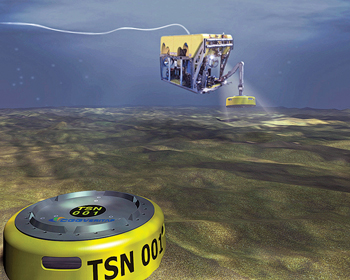
|
| The Trilobit 4C ocean bottom nodes are deployed rapidly using ROVs for reservoir monitoring applications or imaging below congested fields. |
|
World Oil: What is the role of seismic methods for shale exploration, formation evaluation and fracture monitoring?
Malcor: Seismic will be critical to fully tapping the potential of unconventional reservoirs. Led by advances in drilling and fracturing technology, unconventional resources were initially perceived more as a manufacturing process. However, in practice, these reservoirs show a high degree of heterogeneity. Seismic, integrated with borehole data, holds the key to understanding and predicting the variability in production rates in terms of geomechanical properties such as rock strength and stress. Derivation of these properties relies on tailoring the acquisition and processing of the seismic survey for each reservoir. When combined with other seismic attributes, the geomechanical properties can be used to optimize well location, avoid hazards and maximize productivity. Furthermore, microseismic monitoring of the hydraulic fracture process can enable the optimization of fracture density and coverage in real time.
|
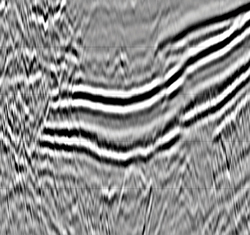
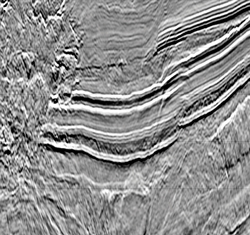
|
| Compared to a conventional survey (top), Broadseis (bottom) acquires data at high resolution and wide frequency bandwidth (2.5 - 155Hz), resulting in a sharp and clean wavelet that yields image clarity and fine details at reservoir depth. |
|
World Oil: You had a role in the development of the solid streamer. Will you be taking a special interest in emerging technologies at CGGVeritas?
Malcor: That’s true and, yes, I am always interested in emerging technologies, as they are critical to our competitive position in the future. Here are a few examples of some of the more intriguing emerging technologies I am currently tracking.
The launch of Giga Transverse by Sercel upgrades the channel capacity of the 428XL land acquisition system from 10,000 to 100,000 channels in real time per line. This breakthrough means we are in a stronger position than ever to meet the challenges set by the ever increasing capacities of SuperCrews, for whom crossing the one-million-channel milestone is now no longer a dream but a fast-approaching reality.
Among the new depth-imaging algorithms that we are currently working on, our new full-waveform inversion delivers advanced high-resolution velocity models and, therefore, more accurate subsurface images.
Offshore, we are also closely following progress in underwater technology such as ROVs and AUVs as well as unmanned water vehicles that have the potential to totally change the way we handle marine seismic operations in the medium-term future.
I would like to conclude with the thought that emerging technologies and their success are ultimately dependent on the people behind them. This year, CGGVeritas is celebrating our 80th anniversary. Throughout our history, we have been at the forefront of innovation, and, looking back, we have a tremendous track record of industry firsts—a real testament to our people. Looking forward, I have a good feeling about the next 80 years, and would enjoy reading the incumbent CGGVeritas CEO’s answers to your questions in the September issue of World Oil in 2091. 
|







